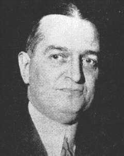(1889-?)

Judge Crater of the New York Supreme Court was last seen on the evening of August 6, 1930, leaving Billy Haas’s chophouse in midtown Manhattan. What happened next is one of the 20th Century greatest mysterious – vanishing acts on record. Even today, 75 years later, historians are scratching their heads trying to piece together the events that lead to the Judge’s disappearance. Is there some clue out there that was overlooked? Was he “rubbed out” by gangsters as many believe or did he change his identity to start a new life in Quebec, the Caribbean, or maybe Youngstown, Ohio? We will never know the answers as time has long ago hidden his fate.
Here is a few of the important details that came out in the investigation following Judge Crater’s disappearance. The tall and dapper 41-year-old Crater was a rising figure in New York City’s Tammany Hall Democratic organization. In June 1930 Judge Crater and his wife went to their summer cottage in Maine. In July he received a telephone call and told his wife he had to return to the city “to straighten those fellows out.” He then proceeded to make a trip to Atlantic City with one of the showgirls he favored and was back in Maine by August 1. On Sunday, August 3rd he returned to New York, promising Stella, his wife, he would return for her birthday on August 9.
He spent Wednesday afternoon collecting papers from his office and stuffing documents into briefcases. He later cashed two checks worth $50,000 in today’s money, and bought a ticket to that night’s performance of a new hit comedy on W. 44th Street. That evening he dined with two friends. One was William Klein, a lawyer, and Klein’s girlfriend, Sally Lou Ritz, an attractive showgirl. About 9 or 9:15, the trio stood on the sidewalk chatting and laughing, the Judge hailed a passing cab, and was last seen waving his Panama out the window to his friends. No one saw Joe Crater again.
At first Stella had been miffed that her husband had missed her birthday, but thought he had been detained on business. His friends thought he went back to Maine. When the Supreme Court opened on August 25th, his fellow justices arrange a discreet inquiry. On September 3rd the inquiry proved fruitless and the police were notified. The missing Judge became front-page news. What followed next was one of the most massive manhunts in New York history. The investigation cost millions of dollars and was complicated by the disappearance of Sally Lou Ritz, the last person to see the Judge alive.
On January 9, 1931, the grand jury was dismissed, after hearing hundreds of witnesses and taking 2,000 pages of testimony. They concluded that there was insufficient evidence to determine if Crater was alive or dead. The State of New York declared the Judge legally dead on June 6, 1939, nine years after he went missing. The police closed the case in 1979.
Every August 6, for more than three decades, an attractive older woman would enter a Greenwich chophouse alone. She would order two cocktails, raise one, and murmur, “Good luck, Joe, wherever you are.” She would drink it slowly, rise, and walk out, leaving the other drink untouched.
